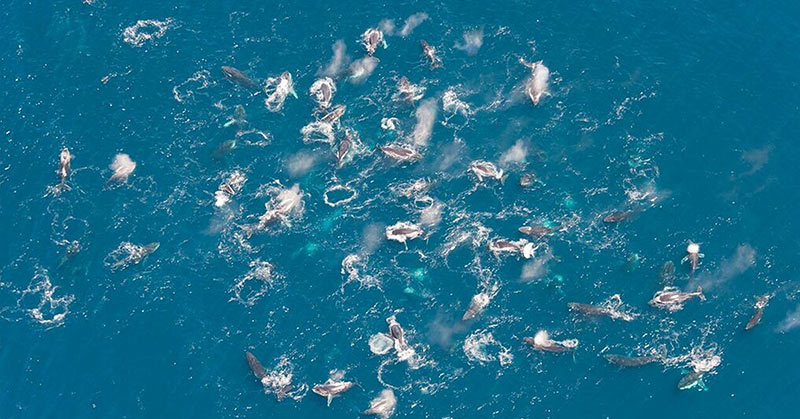Despite their enormous size, humpback whales are powerful yet gentle creatures that live in every ocean. They are a favorite among whale watchers since they are incredible swimmers who can leap in and out of the water. They are also known for their magical “songs” that can be heard over large distances. These songs sound like sequences of moans and cries that can go one for hours. Scientists are studying these songs to learn how whales use them to communicate [1], but that’s not the only humpback behavior that has puzzled researchers.
These typically solitary creatures have gathered in “super-groups” and it baffled scientists for years [3].
A Gathering of 200 Whales
In 2017, this mystery deepened as this “rare” occurrence became more commonplace. A study from 2017 reported spotting pods of whales gathering in groups of about 20 to 200 at a time off the coast of South Africa.
“It’s unlike anything I have seen in working with humpback whales across the Southern Hemisphere,” says study leader Ken Findlay, a marine biologist at Cape Peninsula University of Technology in Cape Town, South Africa. “These are animals that normally are in groups of up to maybe three of four. To see 200 together in an area the size of a football field is remarkable.”
These pods have been observed by Findlay and his colleagues during research cruises in 2011, 2014, and 2015.
The location of the humpback whales is also odd. In the winter, humpbacks migrate to warm waters to breed, and in the summer, they feed in colder waters close to Antarctica. However, they were found around the warmer waters of South Africa in the summer.
Read: Dolphins appear to glow as they glide through bioluminescent waves
Why are these “super-groups” happening?
Findlay’s research team developed some theories to explain these events:
One theory suggests that the humpback whales are hunting for prey, staying in the southern waters instead of going north.
“Either the availability of prey has changed or the behavior of the whales has changed,” says Findlay.
Another theory states that since the species is reproducing to a number scientists haven’t seen before, the whales are reverting to normal behavior that wasn’t occurring when their numbers were lower.
As Findlay explains, it could be the “behavior was always there, but it’s only being seen as the population makes remarkable recovery from the pressure of whaling last century.” [2]
In the 19th and early 20th centuries, commercial whaling reduced the population of humpback whales by almost 90%. At one point, there may have been less than two thousand of these whales in existence. The species began multiplying when the International Whaling Commission banned commercial whaling in 1966 and the Endanger Species Act officially defended humpback whales in 1973. Today, the population has grown to about 60,000 and is flourishing. [3]
“This is a novel feeding technique for South Africa that hasn’t been seen before,” says Regina Asmutis-Silvia, biologist and executive director of Whale and Dolphin Conservation. She was not involved with the study but she has studied whales since 1990 and observed scores of them in Cape Cod. She notes how unusual the study’s “super-group” is, and comments that “it could be indicative of some cultural shift in that population of humpbacks.”
Large groups of whales usually demonstrate that the area is full of prey, and the 200 pods of whales have shown clear feeding behavior according to the study. [4]
Read: Enormous Humpback Whale Filmed Jumping Next To A Fishing Boat
Protecting Whales from Ships near South Africa
Still, the researchers admit that their reasoning behind these strange occurrences is speculative. Although their reasoning sounds positive, that won’t stop people from declaring that this is a sign of the end of the world, that the whales know something people do not. Either way, everyone is happy to see these creatures’ numbers rise in recent years.
Although this study was published in 2017, this pattern of “super-groups” has continued.
Business Insider accounted for pods including as many as 600 whales in December 2019. South Africa is part of their natural migration to Cape Point but the size of the group is unheard of.
Cape Town authorities are encouraging ships in that area to keep 300 meters clear of these “super-groups.”
“We’re asking tour operators who are not necessarily permitted to get up close to whales, like unauthorized tourism vessels and fishing boats, not to approach the whales closer than 300 meters,” says Mduduzi Seakamela, Department of Environment, Forestry and Fisheries (DEFF) marine mammal biologist.
Ships are extremely threatening to whales, according to Alexander Vogel, a developer of the app Seafari.
“…Ship speeds above 10 knots are invariably fatal if a whale is struck. Smaller vessels are also a threat as the higher speed will make up for the lower weight and cause potentially serious injury or death.” said Vogel.
As the number of whales increase, vessel restrictions are being places to protect wildlife.
“There is something spiritual when a whale is looking at you,” says Seakamela. “I don’t know what it is but to stare into a whale’s eye, your spirit is cleansed. It’s something ritual and divine.” [5]
Keep Reading: Blue Whales Have ‘Unprecedented’ Bounce Back From Brink Of Extinction
[1] Humpback Whale. National Geographic. https://www.nationalgeographic.com/animals/mammals/h/humpback-whale/
[2] Ken P. Findlay. Humpback whale “super-groups” – A novel low-latitude feeding behaviour of Southern Hemisphere humpback whales (Megaptera novaeangliae) in the Benguela Upwelling System. PLOS ONE. https://journals.plos.org/plosone/article?id=10.1371/journal.pone.0172002 March 1, 2017
[3] Sarah Gibbens. Mysterious Whale Swarms Perplexing Scientists. National Geographic. https://www.nationalgeographic.com/news/2017/03/humpback-whales-swarms-south-africa/ March 16, 2017
[4] Shannon Ho. Humpback Whales Mysteriously Organize in ‘Super Groups’: Study. NBC Washington https://www.nbcwashington.com/news/national-international/humpback-whales-mysteriously-organize-in-super-groups/2026084/ March 15, 2017
[5] Jay Caboz. TAKE A LOOK: Massive ‘super-groups’ of whales are travelling along SA’s West Coast. Business Insider. https://www.businessinsider.co.za/massive-super-groups-of-humpback-whale-are-travelling-along-the-west-coast-and-ships-have-been-warned-not-to-hit-them-2019-12 December 4, 2019

